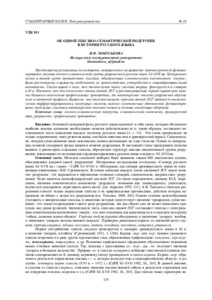Пожалуйста, используйте этот идентификатор, чтобы цитировать или ссылаться на этот ресурс:
https://elib.psu.by/handle/123456789/18436Полная запись метаданных
| Поле DC | Значение | Язык |
|---|---|---|
| dc.contributor.author | Хомуськова, Н. Ф. | - |
| dc.date.accessioned | 2017-01-09T11:49:11Z | - |
| dc.date.available | 2017-01-09T11:49:11Z | - |
| dc.date.issued | 2016 | - |
| dc.identifier.citation | Вестник Полоцкого государственного университета. Серия A, Гуманитарные науки. - 2016. - № 10. – C. 135-139. | ru_RU |
| dc.identifier.issn | 2070-1608 | - |
| dc.identifier.uri | https://elib.psu.by/handle/123456789/18436 | - |
| dc.description | One Lexical-Semantic Subgroup in the History of the Russian Language N. Khomuskova | ru_RU |
| dc.description.abstract | Представлены результаты исследования, направленного на выявление закономерностей функционирования глаголов лексико-семантической группы разрушения в русском языке XI–XVII вв. Центральное место в данной группе принадлежит глаголам, объединенным семантическим компонентом ‘смерть’. Были рассмотрены и выявлены особенности их происхождения, употребления и словообразовательной активности. Сделан вывод о том, что значительная часть глаголов впервые фиксируется в словарях в XI в. Показано, что для лексических единиц данной ЛСГ в рассматриваемый период характерно наличие большого количества префиксальных производных, где анализируемое значение разрушения обусловлено семантикой префикса. Выявлено, что отличительными чертами данной ЛСГ являются стилистическая дифференцированность некоторых глаголов, наличие синонимичных обозначений, функционирование отдельных глаголов в анализируемом значении только в составе устойчивых оборотов.=The article presents the results of a study on regularities of functioning of destruction verbs in the Russian language of the XI–XVII centuries. Verbs with the semantic component of ‘death’ take a central place in this group. The peculiarities of their origin, use and word-formative activity have been revealed and considered. The conclusion is that a significant number of verbs were first fixed in the dictionary in the XI century. It has been shown that the lexical units of this lexical-semantic group in the considered period of time are characterized by a large number of prefixed derivatives, where the analyzed meaning of destruction is caused by the semantics of the prefix. It has been revealed that the distinctive features of this lexical-semantic group are stylistic differentiation of some verbs, synonymy of some verbs, functioning of certain verbs in the analyzed meaning only as the components of set expressions. | ru_RU |
| dc.language.iso | ru | ru_RU |
| dc.publisher | Полоцкий государственный университет | ru_RU |
| dc.relation.ispartof | Веснік Полацкага дзяржаўнага ўніверсітэта. Серыя А, Гуманітарныя навук | be_BE |
| dc.relation.ispartof | Herald of Polotsk State University Series A, Humanity sciences | en_EN |
| dc.relation.ispartof | Вестник Полоцкого государственного университета. Серия A, Гуманитарные науки | ru_RU |
| dc.relation.ispartofseries | Серия A, Гуманитарные науки;2016. - № 10 | - |
| dc.rights | open access | ru_RU |
| dc.subject | Государственный рубрикатор НТИ - ВИНИТИ::ОБЩЕСТВЕННЫЕ НАУКИ::Языкознание | ru_RU |
| dc.subject | лексико-семантическая подгруппа | ru_RU |
| dc.subject | древнерусский язык | ru_RU |
| dc.subject | семантический компонент | ru_RU |
| dc.subject | lexical-semantic subgroup | ru_RU |
| dc.subject | semantic component | ru_RU |
| dc.title | Об одной лексико-семантической подгруппе в истории русского языка | ru_RU |
| dc.type | Article | ru_RU |
| dc.identifier.udc | 811 | - |
| Располагается в коллекциях: | 2016, № 10 | |
Файлы этого ресурса:
| Файл | Описание | Размер | Формат | |
|---|---|---|---|---|
| 135-139.pdf | 176.6 kB | Adobe PDF |  Просмотреть/Открыть |
Все ресурсы в архиве электронных ресурсов защищены авторским правом, все права сохранены.